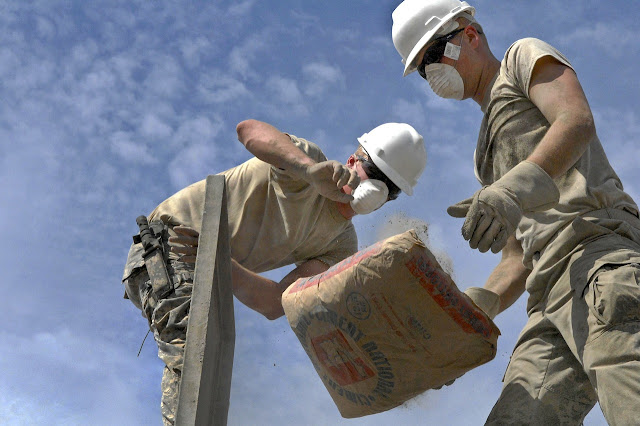MATERIALS THAT USED IN CONCRETE MIXING
MATERIALS
3.1 Cements
Portland cements shall conform to the requirements of AASHTO M 85 (ASTM Cl50) and blended hydraulic cements shall conform to the requirements of AASHTO M 240 (ASTM C595) or ASTM Cl157.
Except for Class P(HPC) and Class A(HPC) or when otherwise specified in the contract documents, only Type I, II, or III Portland cement; Types IA, IIA, or III air entrained Portland cement; or Types IP or IS blended hydraulic cements shall be used. Types IA, IIA, and IIIA cement may be used only in concrete where air entrainment is required.
Low-alkali cements conforming to the requirements of AASHTO M 85 (ASTM Cl50) shall be used when specified in the contract documents or when ordered by engineers as a condition of use for aggregates of limited alkali-silica reactivity.
Unless otherwise permitted, the product of only one mill of any one brand and type of cement shall be used for like elements of a structure that are exposed to view, except when cements must be blended for reduction of any excessive air entrainment where air-entraining cement is used.
For Class P(HPC) and Class A(HPC), trial batches using all intended constituent materials shall be made prior to concrete placement to ensure that cement and admixtures are compatible. Changes of mills, brands, or types of cement shall not be permitted without additional trial batches.
Note 1— Some cement is designated with a combined type classification, such as Type I/II, indicating that the cement meets the requirements of the indicated types and is being offered as suitable for use when either type is desired.
ASTM C 1157 is a performance specification that does not require restrictions on composition or constituents of cement. It can be used to accept cement not conforming to AASHTO M 85 (ASTM C150) and AASHTO M 240 (ASTM C595).
3.2 Water
Water used in mixing and curing of concrete shall be subject to approval and shall be reasonably clean and free of oil, salt, acid, alkali, sugar, vegetable, or other injurious substances. Water shall be tested in accordance with, and shall meet the requirements of AASHTO T26. Water known to have potable quality may be used without tests. Where source of water is relatively shallow, an intake shall be enclosed to exclude silt, mud, grass, or other foreign materials.
Mixing water for concrete in which steel is embedded shall not contain a chloride ion concentration in excess of 1,000 ppm or sulfates in excess as So4 of 1,300 ppm. In JIS A 5308, water which is used for concrete other than tap water is specified as shown in Table 3.2-1.
Table 3.2-1 Specified Quality of Water other than Tap Water Items Specified Value
Suspended solid
Less than 2 g/l
Chloride ion
Less than 200 ppm
Difference of time of setting for cement
Less than 30minutes for initial setting, less than 60minutes for final setting
Ratio of compressive strength of motor
More than 90% at age 7days and age 28days
It is better not to use sea water for plain concrete, because sea water will;
− accelerate alkali aggregate reaction,
− decrease Long-term strength growth of concrete, and
− reduce durability
3.3 Fine Aggregate
In Japan, it is defined as Fine aggregate that passes 85% of its mass or more through “5 mm sieve”. Fine aggregate for concrete shall conform to the requirements of AASHTO M6.
3.4 Coarse Aggregate
In Japan, it is defined as Coarse aggregate that leave more than 85% of its mass on “5mm sieve”. Coarse aggregate for concrete shall conform to the requirements of AASHTO M80.
3.5 Statement of Water-containing
Statement of Water-containing of aggregate is shown in Figure 3.5-1. Water-containing state of aggregate must be “surface dry state” before mixing. If wet state aggregates are applied for mixing of concrete, quantity of surface water must be adjusted as the volume of water.



No comments